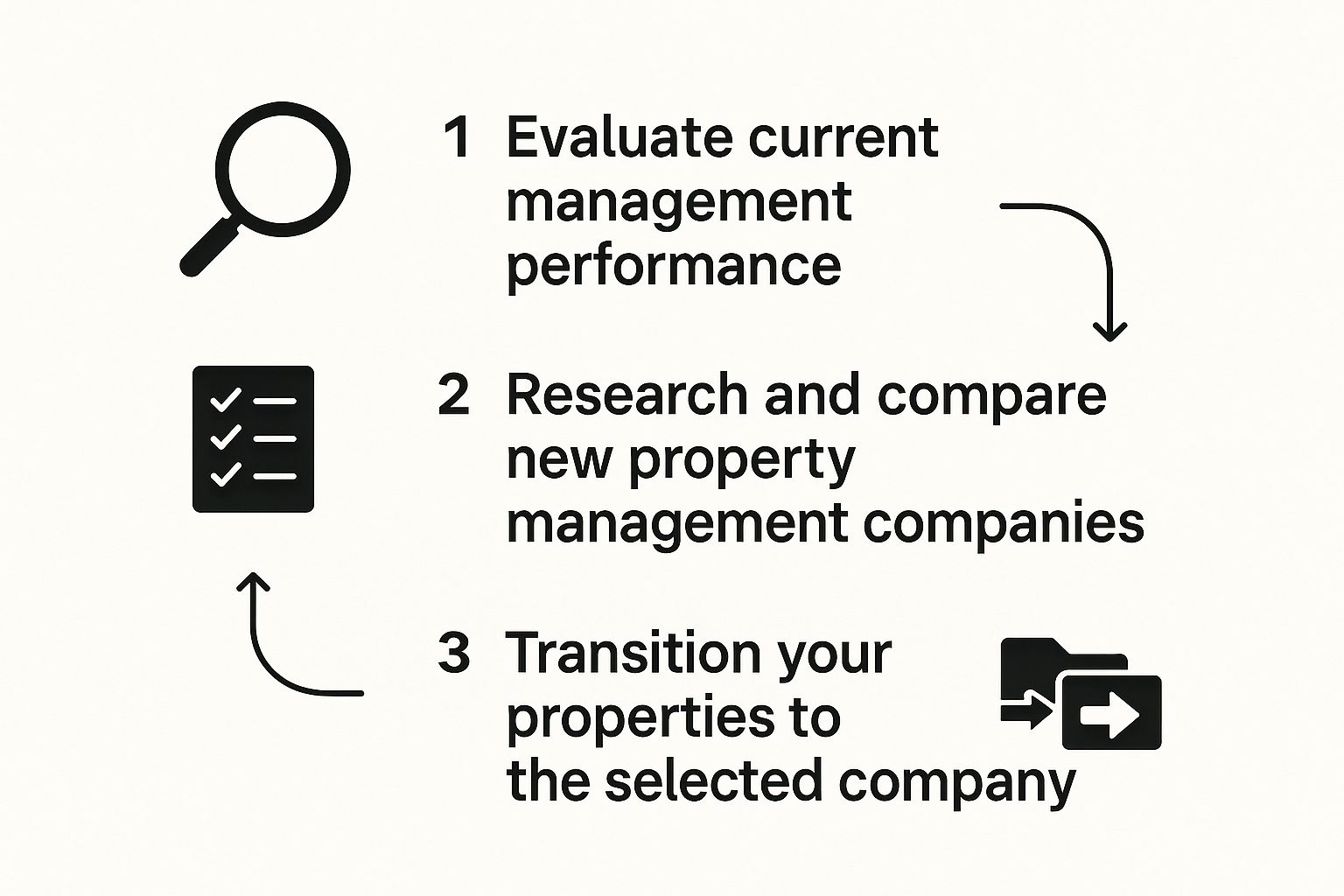A San Diego Owner’s Guide to Switching Property Management Companies
- Mark Palmiere
- 4 hours ago
- 12 min read
TL;DR
Time for a Change? Common red flags include inconsistent occupancy, negative guest reviews, and confusing financial reports. Don't settle for "good enough."
The Process: Review your current contract's termination clause, send a formal written notice, and coordinate a smooth handover of keys, bookings, and documents.
What to Look For: Your new partner must use data-driven dynamic pricing, master a hybrid STR/MTR model to keep your calendar full, and focus on five-star guest experiences.
The WCHS Difference: West Coast HomeStays boosts owner revenue by 20-30% through expert local management, design-forward upgrades, and a seamless, hands-off process.
Feeling stuck with your San Diego property manager? You're not alone. Making the switch isn't just about solving problems—it's a strategic move to boost revenue, slash your stress levels, and finally get your peace of mind back. A truly proactive partner like West Coast HomeStays can unlock your rental's hidden potential, turning an underperforming asset into a profitable, hands-off investment.
Why Switching Your Property Manager Is a Smart Move for Increasing Airbnb Income

The idea of changing your property manager can feel like a huge headache, but it’s honestly one of the most powerful things you can do for your investment. Too many San Diego property owners stick with managers who are just "good enough," not realizing how much money they're leaving on the table.
The right partner doesn’t just collect rent. They are savvy local hosts who actively find ways to increase your property's value and your income with proven results.
This is especially true in a dynamic market like San Diego. For example, a premier local expert like West Coast HomeStays uses a hybrid STR/MTR model to keep calendars full and revenues high. This strategy adapts to seasonal demand, securing high-paying vacationers in the summer and stable, mid-term corporate clients in the off-season. This coastal-cool approach is a game-changer compared to a one-size-fits-all national brand. You can explore our guide on the benefits of local San Diego vacation rental management to see the difference firsthand.
The Growing Need for Specialized San Diego Rental Management
The property management industry is blowing up. The U.S. market is on track to grow from $81.52 billion to $98.88 billion by 2029. All that growth is fueling innovation and specialization, which means better, more effective management solutions are hitting the market all the time. If you're sticking with an outdated manager, you're missing out on modern strategies that could be earning you a lot more.
A change isn't just about fixing what's broken—it's about seizing new opportunities. With a dedicated, data-driven team on your side, owners almost always see:
Higher Occupancy Rates: Smart marketing and dynamic pricing fill those empty nights fast.
Increased Nightly Rates: Professional design and a top-tier guest experience command premium pricing.
Truly Passive Income: Your investment finally starts working for you without demanding all your time.
At the end of the day, switching property management companies is an investment in your property's future, ensuring it performs at its absolute peak.
Warning Signs Your Management Is Underperforming

It usually starts with a gut feeling. You get the sense that your rental property isn't living up to its potential, and you can't shake the feeling that your manager might be the problem. But to make a confident decision, you need to move beyond intuition and look for concrete, data-backed red flags.
These are the warning signs that directly hit your bottom line and your peace of mind. If you find yourself nodding along to more than one of these, it’s a clear signal that it’s time to find a new partner—one who doesn’t just manage, but actively optimizes your investment.
Declining or Inconsistent Occupancy Rates
One of the most obvious signs of trouble is a calendar filled with empty nights, especially when the rest of the San Diego market is buzzing. A few vacancies are normal, but consistent gaps are a huge red flag pointing to a weak marketing or pricing strategy.
Your manager should be on the ball, adjusting rates based on seasonality, local events like Comic-Con, and booking trends. If your Pacific Beach condo sits empty during spring break while similar listings are booked solid, that tells you everything you need to know. Your manager is being reactive, not proactive.
A Flood of Negative Guest Reviews
Your property’s online reputation is its most valuable asset in the vacation rental game. A steady stream of negative reviews is a direct reflection of your management’s performance, often highlighting recurring issues that should have been solved ages ago.
Common themes in poor reviews usually fall into a few buckets:
Slow Communication: Guests feel ignored when simple questions about check-in or amenities go unanswered for hours.
Cleanliness Issues: Reports of dust, leftover items from previous guests, or dirty linens are just unacceptable. It screams poor quality control.
Maintenance Problems: A broken A/C unit in July or a leaky faucet that was never fixed creates a frustrating, memorable—for all the wrong reasons—experience.
"A single one-star review can scare off dozens of potential bookings. Consistent negative feedback doesn't just hurt your immediate revenue; it tanks your listing's long-term ranking and visibility."
A top-tier manager treats every single stay like a five-star experience is on the line, because it is. They fix problems before they turn into public complaints.
Confusing or Incomplete Financial Reports
Your monthly owner statement should bring clarity, not confusion. If you’re getting reports that are late, vague, or missing key details, it's impossible to know how your property is actually doing. You should be able to easily see your gross rental income, management fees, and a clear, itemized list of expenses for cleaning and maintenance.
Opaque financial reporting makes it hard to trust that you're getting the best return on your investment. It also keeps you from making informed decisions. True partners, like **West Coast HomeStays**, provide transparent, easy-to-read statements that show you exactly where every dollar is going.
If you have to chase down answers about your own money, it's definitely time for a change.
How to Make a Clean Break from Your Old Property Manager
Deciding to switch property management companies is one thing; actually making a clean, professional exit is another. A smooth transition is the goal here—it's what protects your rental income, keeps your property from sitting vacant, and sidesteps any messy legal disputes. Think of it less like a confrontation and more like careful, strategic planning.
The entire process hinges on one document: your current management agreement. This is your roadmap for parting ways, so you need to understand every word of it before you do anything else.
This flow chart gives you a high-level look at the steps involved in making the change.

Following this sequence—evaluate, research, and then transition—is the best way to make sure your decision is based on solid data and sets your property up for success with a new partner.
Reviewing Your Current Contract
Your management contract holds all the answers about how to end the relationship. It's time to dig it out and find the termination clause. This is the section that spells out exactly what’s required to move on.
You'll want to pay close attention to a few key details:
Notice Period: Most contracts will require you to give 30, 60, or even 90 days' written notice. Sticking to this timeline is non-negotiable if you want to avoid a breach of contract.
Termination Fees: Some agreements include an early termination penalty. This is especially common if you're trying to end the contract before its official renewal date comes up.
"For Cause" vs. "Without Cause": A "for cause" termination is for a specific failure on their part (like not sending you rent payments), while "without cause" lets you end the agreement for any reason, as long as you follow the notice rules.
Getting a handle on these terms is critical. They set your timeline and tell you what costs, if any, you can expect. For more on local regulations that might play a role in your contract, take a look at our guide to San Diego short-term rental laws.
Sending a Formal Notice of Termination
Once you know your contractual obligations, it's time to send a formal, written notice. While an email might feel like enough these days, sending a certified letter is always the best practice. It creates a paper trail and prevents any future claims that your notice was never received.
Keep your letter professional, direct, and unemotional. It should include:
A clear statement that you intend to terminate the management agreement.
The legal name on the contract and the address of the property.
The effective termination date, calculated from your required notice period.
A request for a final financial statement and the transfer of all documents and assets.
Keep it simple and professional. This isn't the time to list grievances; it's a formal business communication designed to initiate a clean break.
Coordinating the Handover of Assets and Information
This is where the real work of the transition kicks in. A seamless handover is what prevents disruptions for your guests and protects your income stream. You’ll need to coordinate with both your old and new managers to get several key items transferred over.
Making sure everything gets from Point A to Point B smoothly is where a proactive new manager really shines.
To help you stay on top of everything, we've put together a simple checklist. This table will guide you through the essential tasks to ensure nothing gets missed during the handover process.
Property Management Transition Checklist
Use this checklist to ensure a smooth and complete handover when switching property management companies in San Diego.
Task | Status | Notes |
|---|---|---|
Contract Review | ||
Review termination clause in current contract | Note notice period & any fees. | |
Send formal written notice of termination | Use certified mail for a paper trail. | |
Financial Handover | ||
Request final financial statement | Includes all income & expenses to date. | |
Transfer of security deposits | To you or the new management company. | |
Transfer of future guest payments/deposits | Ensure all bookings are honored. | |
Asset & Information Transfer | ||
Collect all keys & access codes | Physical keys, fobs, garage openers. | |
Transfer all future booking information | Guest contacts, dates, special requests. | |
Obtain property documents & records | Leases, vendor contracts, maintenance history. | |
Final Steps | ||
Confirm final utility bill readings | To ensure a clean financial break. | |
Update listing platforms with new manager info | Airbnb, Vrbo, etc. | |
Notify tenants/guests of the change | Provide new contact info & procedures. |
By working through this list, you can ensure your property doesn't miss a beat—or a booking—during the changeover. A well-managed transition sets the stage for a more profitable and stress-free future with your new management team.
Finding A Partner That Understands Modern San Diego Vacation Rentals

Choosing your next property manager is the most critical decision you'll make after deciding to switch. The vacation rental market has moved far beyond just posting a listing and waiting for the phone to ring. Today’s top-performing rentals are powered by smart tech, data-backed strategy, and an obsession with guest experience.
Your new partner needs to speak this modern rental language fluently. They should operate less like a traditional landlord and more like a high-end hospitality brand, using sophisticated tools to maximize your revenue and create stays that guests rave about. This is where the difference between an average manager and a premier one becomes crystal clear.
🌟 Spotlight on West Coast HomeStays✔ 20–30% revenue boost through data-driven strategies✔ Hybrid STR + MTR strategy keeps your calendar full year-round✔ Five-star guest experiences in design-forward homes👉 Book a free strategy call today!
Technology and Data-Driven Pricing
Honestly, a big reason owners start switching property management companies is to get a tech upgrade. The right software can slash administrative busywork in half and boost efficiency by around 40%. With nearly a quarter of management companies already experimenting with AI, falling behind is just leaving money on the table.
The single most important piece of tech in their arsenal should be dynamic pricing software. This isn't about just bumping up rates for the summer. It's about making dozens of micro-adjustments every single day based on market demand, local events like concerts or conventions, what your competitors are charging, and even flight booking trends. A manager still setting rates by hand is a major red flag.
A data-driven approach means your property is always priced for maximum revenue and occupancy. It’s the single biggest lever for increasing your annual income without any physical changes to your property.
Mastery of The Hybrid STR and MTR Model
Relying only on short-term rentals (STRs) can leave your calendar looking pretty empty during San Diego’s shoulder seasons. A truly forward-thinking manager understands the power of a hybrid model, blending traditional vacation stays with mid-term rentals (MTRs) of 30 days or more.
This strategy creates a resilient, year-round revenue stream.
Short-Term Rentals (STRs): You capture the peak demand from tourists during summer, holidays, and big events, maximizing those high nightly rates.
Mid-Term Rentals (MTRs): Then you fill the gaps with high-quality tenants like traveling nurses, corporate contractors, or families relocating to San Diego. This secures stable income during the slower months.
Companies like West Coast HomeStays specialize in this hybrid approach, leveraging deep local connections to keep properties booked and profitable all year long.
A Focus On Design and Guest Experience
Finally, your new manager should see your property not just as a space, but as a product. They need to have a keen eye for design and understand what today’s travelers really want—stylish decor, thoughtful amenities, and seamless, tech-enabled check-ins.
A great partner knows how to handle every part of the operation, including challenges like finding the right security partners in San Diego to protect your asset and ensure guest safety. They invest in professional photography and write compelling, search-friendly listings that pop on platforms like Airbnb and Vrbo.
This commitment to five-star hospitality is what earns glowing reviews, which in turn boosts your listing’s visibility and justifies premium rates. If you want a checklist of what to look for, our guide on how to choose a property management company in San Diego that boosts revenue breaks it all down.
The Real Financial Impact of a Better Manager
Switching your property manager isn't just about getting fewer headaches—it's one of the smartest financial moves you can make for your investment. The difference between a passive manager who just collects rent and a proactive partner who actively grows your revenue is massive.
That financial gap is where an expert's value becomes crystal clear. It's not about luck; it's about a strategic, data-driven approach instead of a "set it and forget it" mentality. The best managers use specific tactics to make sure your property is earning every dollar it possibly can, every single day.
Dynamic Pricing and Smarter Occupancy
One of the single biggest levers for your revenue is dynamic pricing. A top-tier manager isn’t just setting rates for "high" and "low" seasons. They're using sophisticated software to adjust your pricing daily based on what’s happening in the market right now. This includes everything from local concerts and conventions to flight booking trends and what your direct competitors are charging. This strategy alone can be a game-changer for your bottom line.
A strong network and a hybrid STR + MTR model are also crucial. An expert manager knows how to pivot on a dime. They can capture high-value vacationers during peak season, then seamlessly transition to securing reliable, high-paying corporate clients for mid-term stays when things slow down. This keeps your calendar full and your income flowing year-round.
Switching to a manager who truly masters these strategies often results in a 20-30% revenue increase. This isn't just a hypothetical number; it's the tangible result of smarter, more active management.
Justifying Higher Rates with Great Design
A better manager also knows how to boost your property's perceived value. By focusing on professional interior design, adding high-demand amenities, and delivering five-star hospitality, they create an experience that guests are willing to pay a premium for.
It's amazing what a few simple upgrades and professional staging can do. Guided by real market knowledge, these changes make your listing pop, helping it command much higher nightly rates.
If your current management situation is causing financial stress, it's important to know how to solve small business cash flow problems to keep your investment secure while you make the switch. For a deeper dive into setting your rental up for success from day one, take a look at our San Diego Airbnb management guide.
This shift toward modern, strategic management is becoming essential. The global property management market is projected to grow from USD 26.49 billion in 2024 to USD 42.78 billion by 2030. This growth isn't random; it reflects a massive shift toward firms that use technology to maximize returns. That makes your decision of switching property management companies more critical than ever.
FAQ: Switching to a New San Diego Property Manager
Making the leap to a new property manager is a big decision, and it’s only natural to have a few questions. Getting clear, honest answers is the first step to making a switch with confidence.
1. What makes West Coast HomeStays different from other managers?
West Coast HomeStays combines a data-driven, hybrid STR/MTR strategy with boutique-level service. We focus on design-forward upgrades and five-star hospitality to boost owner revenue by an average of 20-30% while delivering unforgettable guest experiences in San Diego's most desirable locations.
2. Can you handle both short- and mid-term stays?
Absolutely. Our expertise lies in our hybrid STR + MTR strategy. This approach maximizes your income by capturing high-paying vacationers during peak season and securing stable, longer-term tenants like corporate travelers or relocating families during slower months, keeping your calendar full all year.
3. How quickly can my listing be optimized?
Our onboarding process is designed for speed and efficiency. Once we have access to your property, we can typically have professional photography, an optimized listing description, and our dynamic pricing strategy implemented within 1-2 weeks, positioning you for higher earnings right away.
4. What amenities do your San Diego homes include?
Our properties are known for being amenity-rich. Standard features often include high-speed Wi-Fi, smart TVs, fully-equipped kitchens, premium linens, and keyless entry. Many of our homes also feature popular extras like pools, hot tubs, dedicated workspaces, and family-friendly or pet-friendly accommodations to attract a wider range of high-value guests.
5. Do you help with design upgrades to boost nightly rates?
Yes, this is a core part of our value. We provide expert design consultations to identify cost-effective upgrades—from a simple furniture refresh to a full-scale redesign—that have a proven ROI. Our goal is to transform your property into a stylish, sought-after rental that commands premium nightly rates.
If you’re ready for truly hands-off, higher-earning rentals in San Diego, West Coast HomeStays is the partner to trust. **Book a complimentary strategy call today!**
